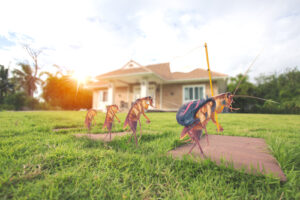How to Get Rid of Fleas: Frequently Asked Questions
Flea infestations can strike tenants when they least expect it, and these pests are inconvenient at best, but outright dangerous at worst. They can bite you, burrow into your furniture and hair, and spread diseases to you and your pets. Luckily, there are simple tools you can use to eliminate these bugs. In this article, we’ll answer frequently asked questions about flea infestations, how to handle them, and whether tenants or landlords are responsible for them.
Table of Contents
9 Common Questions When Your Rental Has Fleas
Needless to say, you’re probably wondering: what do I do now? How do I even begin to handle this problem? No need to worry, though, because property managers in North Virginia have your back. We know how to tackle an infestation. You can help keep this mess under control by following our answers to the most common flea infestation questions.
 What Are the Signs of a Flea Infestation?
What Are the Signs of a Flea Infestation?
Home Veterinary Care of Northern Virginia (HVCNV) offers solid flea infestation advice that applies to more than just cats and dogs. Strap in your seatbelts and think happy thoughts, because some of this info (we’re sure you’ll be thrilled to know that fleas can jump 13 feet to clutch onto pet fur!) isn’t a walk in the park. Although it’s tough, it’s possible to see signs of a flea infestation in your rental home – even if you don’t have an itchy pet. Pay close attention to furniture, carpeting, and bedding and look for tiny black dots.
What are Flea Infection Health Risks?
Unfortunately, we must start by diving into the deep end. Fleas may seem like small annoyances, but they spread diseases like Flea Allergy Dermatitis, Flea Bite Anemia, and Tapeworm infestation.
Can Fleas Infest Human Hair and Body?
Fleas don’t just affect animals. They can infect humans, too. While animals are usually permanent hosts, not humans, fleas still can bite humans and fleetingly hide out in their hair. Worst of all, if fleas give cats Cat Scratch Fever, cats can then scratch and spread the disease to humans.
How Do I Know If I Have a Flea Infestation?
Itching and irritation are the main indications of flea infestations. Out of the blue, you and your pets may itch more than usual, especially in their neck and tail head sections.
Smaller infestations may not show much visible evidence. However, on other animals and surfaces, you might discover the odd flea or dirt-like flea droppings. For example, signs of a flea infestation in beds include flea dirt and spare fleas lounging around. Also, a flea infestation on a dog may involve bites or flea dirt burrowed deep in their fur.
 How Do I Tell How Bad a Flea Infestation Is?
How Do I Tell How Bad a Flea Infestation Is?
The more extensively and severely that tell-tale signs of flea infestations appear in your home, the worse your flea infestation may be. For instance, if your home is littered with flea dirt—and not just in a few areas—then your flea infestation may have worsened.
Can I have a flea infestation without pets?
Yes, fleas can infest spaces without pets, too. They can infiltrate your furniture and flooring.
How to Get Rid of Fleas
There are several flea infection treatments you can use on pets. You should use treatments for three months because fleas can live for months. Furthermore, you must regularly treat all your pets, not just the visibly affected ones. This is especially true for cats, who are fleas’ top pick as hosts. Here is how to get rid of fleas on dogs and cats:
Flea Infection Treatments for Pets
- Flea combs: Flea combs latch onto fleas and flea droppings. A vet team can help verify whether the findings are flea-related or not.
- Pills: Pills can be beneficial for pets. However, owners need to take special care when they use pills on younger, older, and sick animals. It’s a good idea to check with your vet directly to see whether a pill is safe for your pet.
- Injections: Flea treatment injections can sterilize fleas to prevent future flea reproduction. This does not apply to fleas already on your pet or ones already growing.
- Topical Products: Topical products last long enough to kill fleas and flea eggs for up to a month. However, you should use three months of flea treatment to fully exorcise emerging younger fleas. They recommend you ask a vet about topical products with safe, effective ingredients. Not all solutions are made equally.
- Flea Shampoos: Flea shampoos may kill most fleas. However, the shampoo will only impact the fleas on your pet right now, so you should apply it repeatedly. If you also use topical products, do this only a few times a month so it doesn’t wear off. You should massage the shampoo all over your pet to ensure you get to as many fleas as possible. Pause a few minutes, then rinse, to make sure it all soaks in.
It’s important to note a few things. Firstly, flea collars don’t always work well, and neither do flea powders. More importantly, cats can tragically die if you give them the wrong flea treatment.
For instance, you should always be positive that cat-geared products don’t contain permethrin and amitraz. Always ensure that cats aren’t exposed when dogs take in these ingredients. Do not accidentally give cats products that are made for dogs.
 What Flea Treatments Should I Use for My Home?
What Flea Treatments Should I Use for My Home?
Fleas in your house are constantly growing and spreading everywhere. That’s why it’s critical to address your environment, not just your pets or own self, for optimal removal. Fortunately, there are several ways to get rid of fleas in your house.
Products like special sprays and soaps are good home flea treatments. Make sure these products seep through and under infected materials so you target the eggs and larvae.
Additionally, it is a good idea to vacuum before you implement these items, as vacuums will pull the surface carpet fibers off and allow for the product to soak in more directly.
Where Should I Use Flea Treatments in My Home?
There are two areas you should consider using flea treatments in your home. These are your yard area and your indoor areas. Here are the details below.
- Yard areas: Yard bushes, mulch, and other moist, shaded areas are ripe for flea infestation. Products with synthetic pyrethroids, like cyfluthrin and fenvalerate, can be effective. Well-lit areas will not need this flea treatment.
- Indoor areas: Fleas can sliver their way into places and objects that require cleaning, so you should vacuum all spaces and furniture and launder all your clothes. They like the dark, so they will infiltrate your carpet, the furniture underside, and floor cracks. Particularly, fleas can infest hardwood floors.
Who is Responsible for Pest Control in Rentals?
Landlords and tenants have joint responsibility for pest control. Landlords must maintain a property’s habitability. However, it’s on tenants to keep the property flea-free and inform landlords if these unwanted guests do sneak in.
 In a March 2024 Virginia court ruling, property pest control law was tested. A rental resident filed a Tenant’s Assertion and Complaint alleging that the single-family home she rented had a flea infestation.
In a March 2024 Virginia court ruling, property pest control law was tested. A rental resident filed a Tenant’s Assertion and Complaint alleging that the single-family home she rented had a flea infestation.
The tenant was introduced to the property through FaceTime, not in person. When she moved in, she found fleas in her bed, informed the landlord, and sought exterminator services. However, on the landlord’s end, he failed to provide a sufficient number of treatments in a timely fashion.
In court, the landlord argued that his lease agreement transferred pest control duties to the tenant, while the tenant argued that landlords cannot waive their legal warranty to keep the unit habitable.
The court found the owner’s argument to be invalid. The resident had to fulfill her legal role in maintaining the property and notifying her landlord of any issues, which she did. On the other hand, the landlord had a responsibility to ensure the habitability of the home before transferring to the tenant – and he didn’t.
This lawsuit shows landlords that they must cooperate with tenants to maintain the condition of the property. In addition, both landlords and tenants should take part in an in-person and written move-in inspection as a critical first step. Paper trails, open discussions, and teamwork can help protect landlords from legal action.
Get More Guidance with BMG
You can get rid of the fleas infesting your furniture, floors, pets, and even your own body. Vacuuming, laundering, and formulated products can help you get rid of these pests. When that fails, professional pest control is your best option for significant infestations.
Bay Property Management Group has years of experience dealing with tenant issues. If the details here made you queasy, we could take one for the team and coordinate flea elimination for you. Best of all, that’s not all we do. We take care of the everyday issues that could plague the rental experience. Call Bay Property Management Group in North Virginia today to let a team of professionals handle your biggest renting problems.



